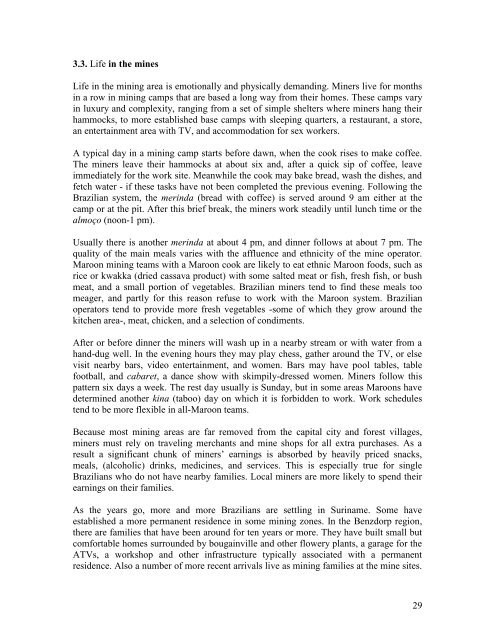SITUATION ANALYSIS OF THE SMALL-SCALE GOLD ... - WWF
SITUATION ANALYSIS OF THE SMALL-SCALE GOLD ... - WWF
SITUATION ANALYSIS OF THE SMALL-SCALE GOLD ... - WWF
Create successful ePaper yourself
Turn your PDF publications into a flip-book with our unique Google optimized e-Paper software.
3.3. Life in the mines<br />
Life in the mining area is emotionally and physically demanding. Miners live for months<br />
in a row in mining camps that are based a long way from their homes. These camps vary<br />
in luxury and complexity, ranging from a set of simple shelters where miners hang their<br />
hammocks, to more established base camps with sleeping quarters, a restaurant, a store,<br />
an entertainment area with TV, and accommodation for sex workers.<br />
A typical day in a mining camp starts before dawn, when the cook rises to make coffee.<br />
The miners leave their hammocks at about six and, after a quick sip of coffee, leave<br />
immediately for the work site. Meanwhile the cook may bake bread, wash the dishes, and<br />
fetch water - if these tasks have not been completed the previous evening. Following the<br />
Brazilian system, the merinda (bread with coffee) is served around 9 am either at the<br />
camp or at the pit. After this brief break, the miners work steadily until lunch time or the<br />
almoço (noon-1 pm).<br />
Usually there is another merinda at about 4 pm, and dinner follows at about 7 pm. The<br />
quality of the main meals varies with the affluence and ethnicity of the mine operator.<br />
Maroon mining teams with a Maroon cook are likely to eat ethnic Maroon foods, such as<br />
rice or kwakka (dried cassava product) with some salted meat or fish, fresh fish, or bush<br />
meat, and a small portion of vegetables. Brazilian miners tend to find these meals too<br />
meager, and partly for this reason refuse to work with the Maroon system. Brazilian<br />
operators tend to provide more fresh vegetables -some of which they grow around the<br />
kitchen area-, meat, chicken, and a selection of condiments.<br />
After or before dinner the miners will wash up in a nearby stream or with water from a<br />
hand-dug well. In the evening hours they may play chess, gather around the TV, or else<br />
visit nearby bars, video entertainment, and women. Bars may have pool tables, table<br />
football, and cabaret, a dance show with skimpily-dressed women. Miners follow this<br />
pattern six days a week. The rest day usually is Sunday, but in some areas Maroons have<br />
determined another kina (taboo) day on which it is forbidden to work. Work schedules<br />
tend to be more flexible in all-Maroon teams.<br />
Because most mining areas are far removed from the capital city and forest villages,<br />
miners must rely on traveling merchants and mine shops for all extra purchases. As a<br />
result a significant chunk of miners‟ earnings is absorbed by heavily priced snacks,<br />
meals, (alcoholic) drinks, medicines, and services. This is especially true for single<br />
Brazilians who do not have nearby families. Local miners are more likely to spend their<br />
earnings on their families.<br />
As the years go, more and more Brazilians are settling in Suriname. Some have<br />
established a more permanent residence in some mining zones. In the Benzdorp region,<br />
there are families that have been around for ten years or more. They have built small but<br />
comfortable homes surrounded by bougainville and other flowery plants, a garage for the<br />
ATVs, a workshop and other infrastructure typically associated with a permanent<br />
residence. Also a number of more recent arrivals live as mining families at the mine sites.<br />
29
















